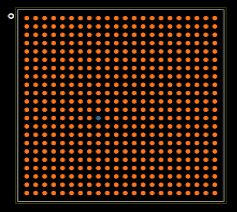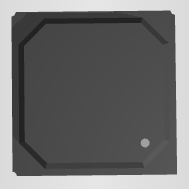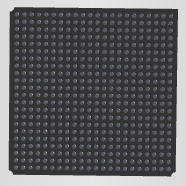5CEFA5F23C8N FPGAs: Features, Applications and Datasheet
2025-04-27 11:31:37 1393
5CEFA5F23C8N Description
The 5CEFA5F23C8N is part of Intel’s (formerly Altera’s) Cyclone® V E FPGA family, tailored for low-power, high-performance applications. It integrates a balance of logic density, embedded memory, and digital signal processing (DSP) blocks, making it a powerful solution for system-on-chip (SoC) integration. With a compact form factor and cost-effective pricing, it's ideal for embedded designers looking to accelerate performance without compromising efficiency.
5CEFA5F23C8N Features
Optimized for Mid-Range System Integration
This FPGA hits the sweet spot for engineers needing a balance between logic density and low power — it’s designed to offer high logic utilization without the thermal or cost challenges of high-end FPGAs.
Dual-Purpose I/O Bank Flexibility
It features I/O banks that support mixed-voltage standards, making it ideal for designs where legacy and modern interfaces must coexist. You can drive different voltage domains without external level-shifting.
Hardened Floating-Point DSP Blocks
Unlike generic DSP blocks, the ones in this chip are built to support floating-point math more efficiently — which means you can run moderate complexity signal processing tasks natively without resorting to soft logic.
Logic-Aware PLL Structure
The built-in Phase-Locked Loops aren’t just for clock generation — they’re intelligently mapped within the fabric to reduce routing congestion when creating complex clock domains, which boosts timing closure.
Advanced Power Gating Control
This device supports fine-grained power management features, allowing designers to dynamically disable unused logic blocks — giving embedded developers a significant edge in managing power budgets in real time.
ECC Support in On-Chip RAM
The embedded memory blocks can be configured with Error Correction Code (ECC), which is a major plus for applications needing fault tolerance in mission-critical or long-life designs.
Seamless Migration Path from Cyclone IV
The pin-compatible and architecturally similar layout to Cyclone IV FPGAs ensures easier upgrades in existing designs without requiring full board redesigns.
Enhanced Timing Analyzer Integration
Its architecture allows deeper insights into timing behavior when used with Intel Quartus Prime — making the development/debug process faster, especially for complex timing-critical subsystems.
Support for Partial Reconfiguration
The chip allows sections of logic to be reprogrammed independently while the rest of the FPGA keeps running — an advanced feature useful for field upgrades or real-time adaptive systems.
Robust Clock Domain Crossing (CDC) Handling
Cyclone V E FPGAs incorporate hardened CDC circuitry that reduces metastability issues when working with multiple asynchronous clocks — especially valuable in sensor fusion and mixed-protocol applications.
5CEFA5F23C8N Applications
Industrial Automation: Real-time control and signal processing for PLCs, robotics, and motor control
Video/Image Processing: Frame buffering, scaling, and image enhancement
Communications: Protocol bridging, MAC layer processing, and packet inspection
Medical Devices: Low-latency data acquisition and filtering
Embedded Computing: Co-processing and offloading tasks from main CPUs in embedded systems
5CEFA5F23C8N CAD Model
Footprint

3D Model



5CEFA5F23C8N Alternatives
Similar in functionality to the 5CEFA5F23C8N, the 5CEFA5F23I7N is a direct industrial-grade equivalent that is better suited for harsh environments due to its wider operating temperature range. Similar in logic and pin count but with significantly poorer performance and integration, the EP4CE55F23C8N from the previous Cyclone IV series is perfect for applications where cost is a concern. A more power-efficient option is the 10CL080YU484C8G, part of the Cyclone 10 LP family, developed for systems demanding both high logic density and low power consumption. A cross-platform substitute that is suitable for people accustomed to Xilinx workflows is the XC7A50T-1FGG484C from Xilinx's Artix-7 range, which provides comparable capacity with support from Vivado tools. Lastly, the LFE5U-85F-6BG381C, a member of Lattice’s ECP5 family, is optimized for embedded vision and industrial automation, emphasizing low power and high-speed interfaces with an attractive cost structure.
5CEFA5F23C8N Manufacturer
Intel Corporation is a global leader in semiconductor innovation, renowned for pioneering technologies that power the world’s computing infrastructure. Founded in 1968 and headquartered in Santa Clara, California, Intel designs and manufactures advanced integrated digital technology platforms, including CPUs, FPGAs, SoCs, and connectivity products. Its processors have become the backbone of everything from personal computers and servers to embedded systems and data centers.
Beyond CPUs, Intel is deeply involved in areas like artificial intelligence, autonomous driving, 5G communications, and edge computing, continually pushing the limits of Moore’s Law. With a strong commitment to research and development, Intel invests heavily in next-generation chip architectures, advanced process nodes, and software optimization, solidifying its position as one of the most influential and innovative companies in the tech industry.
5CEFA5F23C8N FAQs
1. Can the 5CEFA5F23C8N be used for soft-core processor implementation like Nios II?
Yes. It fully supports Intel’s Nios® II soft-core processors, enabling designers to embed a customizable processor for real-time control and logic offloading.
2. What configuration methods are supported for this FPGA?
The device supports JTAG, Active Serial (AS), and Passive Serial (PS) configuration using onboard or external configuration memory.
3. Does this FPGA support differential signaling standards (e.g., LVDS)?
Yes. It supports various I/O standards, including LVDS, LVTTL, and SSTL, depending on the voltage bank settings.
4. Is partial reconfiguration possible with 5CEFA5F23C8N?
No. Partial reconfiguration is not supported on Cyclone V E series. For that capability, you'd need Stratix or Arria FPGAs.
5. What is the advantage of using this device over older Cyclone IV FPGAs?
It offers higher performance per watt, improved logic density, better DSP block integration, and support for hard memory controllers, reducing the need for external components and improving system integration.




